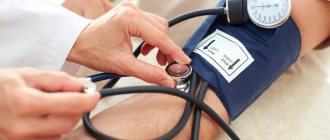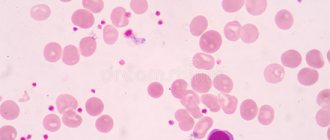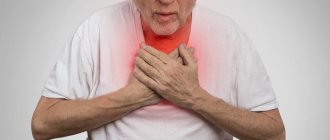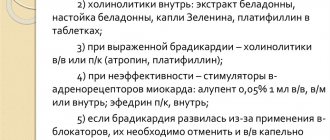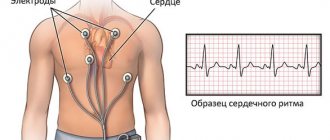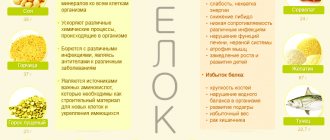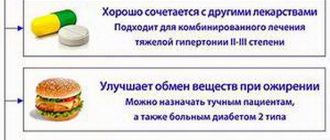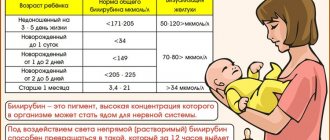- dizziness, weakness, fatigue, decreased performance, drowsiness, decreased memory, slowed reaction, decreased concentration, headaches;
- feeling of heartbeat, chilliness of the extremities;
- pallor, sweating, nausea;
- pain in the neck and upper shoulder girdle, lower back, in the heart area; hearing disorders (hearing impairment, noise or crackling in the ears);
- visual disturbances (blurredness, increased variegation, loss of color perception, narrowing of visual fields, final loss of vision).
- in conditions that are accompanied by a decrease in the volume of blood circulating in the body (bleeding, diarrhea, vomiting, excessive sweating in hot weather);
- after eating (postprandial syncope), due to the accumulation of blood in the veins of the gastrointestinal tract;
- for diseases affecting the structures of the central and peripheral nervous system (Parkinson's disease, Alzheimer's disease, diabetes mellitus);
- when standing for a long time, especially in a stuffy room, when experiencing pain, fear (fear of blood), during medical procedures.
- regular moderate physical activity with stress on the muscles of the legs and abdomen (especially swimming);
- wearing compression stockings on the legs and a bandage on the stomach (for older people);
- consumption of a sufficient amount of table salt (up to 10 g/day) and water (up to 3 l/day) provided there is no arterial hypertension;
- rest after eating in a sitting or lying position for 1-2 hours (for postprandial fainting);
- discontinuation or dose adjustment of medications that lower blood pressure;
- giving up alcohol;
- avoidance of heavy lifting, excessive physical effort,
- refusal to stand for long periods of time;
- Avoiding prolonged exposure to hot water, such as hot showers and spa treatments.
Do fainting occur with low blood pressure?
Why does this happen and what to do about it? – Yes, one of the mechanisms of fainting is precisely a sharp decrease in pressure. This often occurs when the body changes position from horizontal to vertical (orthostatic syncope) due to the rapid accumulation of blood in the veins of the legs, decreased filling of the right ventricle of the heart and further dilation of blood vessels.
Normally, a person has mechanisms for quickly adapting blood pressure and heart rate (HR) to changes in body position in order to maintain a more or less constant level of blood supply to the brain.
In a healthy person, in response to a decrease in blood pressure, blood vessels narrow and the heart rate increases. When this mechanism is disrupted, the vessels, on the contrary, dilate, and blood pressure decreases even more - blood flow to the brain decreases, and fainting occurs.
This mechanism of fainting occurs:
The trigger may be coughing, laughter, defecation or urination, turning the head or pressure in the neck (carotid sinus syndrome), for example due to tumors, when wearing narrow collars.
Such fainting is classified as reflex; they are quite favorable, but can be dangerous due to injuries sustained during a fall, especially in older people. Lifestyle changes can often help reduce the risk of fainting and hypotension.
In this case, a person should avoid exposure to possible triggers and provoking situations. And a quick drink of cold water in a volume of 200-400 ml helps prevent postprandial and orthostatic fainting.
Also useful:
What low blood pressure is considered life-threatening?
– Life-threatening blood pressure levels may vary for each person and situation.
When blood pressure is below 90/60 mmHg. Art. Most people experience neurological symptoms: dizziness, lightheadedness and fainting. When systolic blood pressure is below 80 mm Hg. Art. the kidneys stop performing their filtration function, shock develops.
But, for example, in hypertensive patients with initially high blood pressure, a sharp and rapid decrease in blood pressure can cause loss of consciousness and even ischemic stroke (with a systolic blood pressure of 100–110 mm Hg). But people of asthenic physique with low body weight (constitutional hypotension) with a blood pressure of 90/60 mm Hg. Art. can feel great.
Causes of the symptom
The causes of short-term loss of consciousness are as follows:
- heat. One person can withstand 40°C, but for another 38°C is already a big problem, especially if the room is not ventilated. Fainting most often occurs in crowded vehicles;
- extreme thirst or hunger. This is especially true for people who are trying to quickly lose weight. Also, causes of fainting can be diarrhea, severe vomiting, sweating, frequent urination, due to which the body suffers from fluid loss. This also applies to food poisoning;
- sudden transition from a lying to a sitting or standing position. Many people describe why they fainted like this: they suddenly stood up and their vision blurred;
- anxiety. Because of it, breathing may become very rapid;
- shock and severe pain;
- nervous shock, as well as phobias (for example, the sight of blood can cause fainting). Possible cerebral vasoconstriction due to hypocapnia. Carbon dioxide decreases, while oxygen consumption increases. This state of the body is typical for stress, panic, fear;
- rapid and severe blood loss. Fainting is not due to the fact that a lot of fluid has been lost, but to the fact that the body has not had time to activate its defense mechanisms;
- a decrease in circulating blood volume (this phenomenon is called hypovolemia) due to the fact that the person who fainted took a lot of vasodilators or diuretics;
- a sharp decrease in blood pressure. Fainting is common among hypotensive patients. Loss of consciousness is also possible with vegetative-vascular dystonia;
- a sharp decrease in blood sugar levels. This phenomenon is called hypoglycemia. By the way, this is not always associated with an overdose of insulin in patients with diabetes. The drug can also be used to increase weight (especially bodybuilding fans), which is dangerous for the body;
- anemia. It is also known as anemia;
- swallowing food if the patient has diseases of the esophagus, for example, this may be a reflex reaction that is caused by irritation of the vagus nerve;
- side effects after taking certain medications. This group of causes also includes overdose of antihypertensive drugs;
- cough and urination. Due to the fact that intrathoracic pressure increases, venous return decreases, which means a limitation of cardiac output and a decrease in blood pressure readings;
- decreased blood supply to certain parts of the brain due to various disorders. It could be a mini-stroke;
- cardiovascular diseases. For example, such a symptom causes myocardial infarction;
- some endocrine diseases that cause severe disruptions in the hormonal system, which negatively affects the functioning of all organs and systems;
- neoplasms in the brain. This includes benign and malignant tumors, hematomas.
The causes of fainting can be both trivial and quite serious. This symptom should not be ignored. In children, frequent fainting may be a sign of heart rhythm disturbances, which is quite difficult to recognize in young children (especially at an early age). But most often in people, fainting is caused by changes in blood flow, a decrease in blood pressure. The body simply cannot adapt to sudden changes.
Is it possible to raise blood pressure on your own at home?
– At home, in order to raise blood pressure, you can drink tea or coffee, eat something salty, and quickly drink 1-2 glasses of cold water (with ice in large sips).
You can also use so-called physical counterpressure maneuvers: crossing your legs in combination with maximum tension in the muscles of the legs, abdomen and buttocks; maximum squeezing of the rubber ball in the hand; squeezing one hand with the other with gradual abduction of the hands (phalanxes of the fingers in a lock in front of the chest).
All this is done with effort, muscle tension for as long as possible, until the symptoms disappear completely.
Diagnostics
The main task when examining a patient with fainting is to exclude organic heart disease. If any abnormalities are revealed during the examination, you should make sure that they are related to the patient’s complaints.
- Cardiogenic syncope is the most dangerous, therefore, if the cardiogenic nature of syncope is suspected, the patient should be hospitalized for examination.
- The etiology of most syncope (one third to one half) remains unknown. However, there is always an attempt to find the cause of syncope, since the mortality rate of patients with syncope is higher than in the general population.
- In the elderly, fainting is often caused by several reasons, in particular taking medications, organic heart disease, anemia, hypovolemia, and decreased baroreceptor sensitivity.
- The examination plan is drawn up individually. This allows you to make a diagnosis and at the same time avoid unnecessary tests.
Of the laboratory methods in diagnosing the genesis of syncope, a general analysis of urine and blood, a study of the gas composition of the blood, determination of blood sugar, a glucose tolerance test, and a biochemical blood test help. The evaluation plan for patients with syncope usually includes:
- ECG, EEG, REG, Echo-EG, USDG of extracranial vessels.
- If a cardiogenic nature of syncope is suspected, cardiac ultrasound, phonocardiography, 24-hour ECG monitoring, and stress tests are additionally prescribed.
- If organic brain damage is suspected, then MSCT or MRI of the brain, MRA, duplex scanning or transcranial ultrasound, and radiography of the spine in the cervical region are performed.
- In the diagnosis of syncope of unknown origin, the tilt test has found widespread use, allowing one to determine the mechanism of occurrence of syncope.
What foods can help with low blood pressure, and which ones should not be consumed?
– For low blood pressure, as I said earlier, it is recommended to consume large amounts of table salt (up to 10 g/day) and liquids (up to 3 l/day), and caffeine-containing drinks.
With postprandial hypotension, you need to adhere to a certain type of diet: eat often, in small portions, more proteins and fats, avoid carbohydrates (especially refined ones), eat warm or cold (not hot) foods. And you should give up alcohol.
In what situations should you definitely consult a doctor – and which one? – Patients with fainting, especially those that occur for the first time, need to consult a cardiologist, and, if necessary, a neurologist.
If blood pressure was previously normal or elevated, and then became chronically low, you should also contact a cardiologist to find out the cause. How to monitor your blood pressure and control its reduction?
– In order to prevent another decrease in blood pressure, it is necessary, firstly, to determine the cause (hypothyroidism, anemia, adrenal insufficiency, taking high doses of antihypertensive drugs, etc.) and, if possible, eliminate it.
Secondly, try to avoid provoking situations and factors, observe safety conditions during verticalization, and lifestyle recommendations.
And in situations where a person anticipates developing hypotension or fainting (increased sweating, nausea), you can help yourself by using the physical counterpressure maneuvers that I described earlier.
What to do if you have a symptom
It is imperative to know the rules for providing first aid in case of fainting. First of all, it is necessary to restore hemodynamics by placing the torso in a horizontal position. In this case, you need to raise your legs a little.
First of all, it is necessary to create conditions for oxygenation of the brain. To do this, you need to lay the patient down, loosen his belt, tie, unbutton his jacket or shirt. You should also open a window or door to provide fresh air. It is recommended to spray cold water on the face of a fainting person or bring a cotton swab with ammonia to the nose. These actions during fainting will cause reflex stimulation of blood vessels and respiratory centers.
When to urgently call an ambulance
It is necessary to call an ambulance in cases where one of the following symptoms appears:
- fainting lasts more than a minute;
- the victim’s face began to turn blue, especially his lips;
- the victim cannot feel the pulse, there is no breathing;
- the victim woke up, but his heart rhythm was too slow or irregular;
- after fainting, chest pain, difficulty breathing;
- after fainting, the victim immediately falls asleep and cannot be woken up;
- when fainting or after it, convulsions begin;
- after fainting, the victim says that his vision has deteriorated, everything is cloudy before his eyes, it is difficult for him to speak, and his consciousness is confused;
- When a person faints, he is injured when he falls.
In severe cases, with a significant decrease in blood pressure, if standard measures to help with fainting do not help, then sympathicotonics are administered. If the patient has arrhythmia, then antiarrhythmics are used, and in case of cardiac arrest, atropine is administered and chest compressions are performed.
You can call the ambulance team of JSC "Medicine" (clinic of academician Roitberg) by calling +7 (495) 229-00-03. It is best to do this as soon as signs of fainting appear.
When to see a doctor
If fainting begins to appear frequently or is prolonged, you should visit a neurologist for consultation. You should also go to the hospital if you experience the symptoms described above.
Traditional methods
These traditional medicine recipes are recommended for people prone to fainting:
- Linden decoction. Take 2 tbsp. l. crushed linden flowers, pour 400 ml of hot water, boil for 10 minutes, leave until cool, strain. Drink 200-400 ml at night as a sedative and analgesic for nervous diseases and fainting.
- Lemon juice. If you don't have ammonia, you can use lemon. In this case, you need to immediately sprinkle the juice from the lemon peel into the victim’s nose, and rub the temples with the same peel. It is advisable to prepare 200 ml of water acidified with lemon and give it to the awakened person to drink.
- Fruit juices. Doctor V. Yatsko from Donetsk recommends drinking 200 ml of orange, tangerine or grape juice to prevent fainting.
- When a child faints. If you don’t have ammonia on hand, take a head of onion, cut it and let it smell. You can apply chopped onions to your temples and forehead. Bite the little finger of the left hand (in the center of the first phalanx), press firmly with the index finger under the nose. Wipe your face and chest with cold water.

